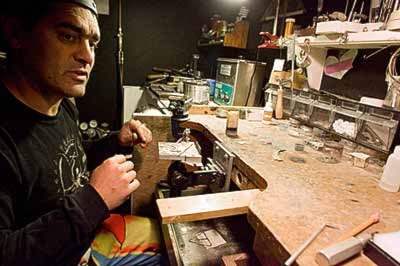Take what is ravished and make it beautiful.
For more than a decade, that has been the vision of Whitehorse artist James Kirby.
A prolific sculptor and jeweler, Kirby works almost exclusively with materials reclaimed from tarnished industrial landscapes.
“I take things out of the environment that people have destroyed … things that every other living being would just step over,” he said.
His work is like an artistic rebellion against the destructive forces of industry.
“We take all this base mineral out of the earth to make steel to build garbage to sell people junk and we basically shoot ourselves in the foot by doing that.”
“We’re not paying attention to what’s really there, we’re paying attention to one aspect of what’s really there.”
Kirby fashions his art in a large studio near the banks of the Yukon River that once served as an RCMP horse stable.
Cracked, broken and misshapen rocks are heaped in a waist-high pile at the back of his studio. They are some of Kirby’s reclaimed treasures.
He pointed to a large granite stone, rendered useless by a series of large fissures along its side.
“I found this outside the quarry at Whitehorse copper,” he said.
“I’ll seal up all the cracks, I’ll carve a totem pole in the front and then I’ll sell it for $30,000.”
At his jewelling bench, Kirby showcased his stone collection.
He held up a small stone that glistened with an intricate octagonal pattern: 275 million-year-old colonial coral.
“That’s what you drive on on the Dempster Highway,” he said.
“That whole highway was an ocean.”
A piercing blue stone catches my eye: blue coral.
Found by Kirby in the Yukon River, he said it originates from the Western Pacific, around the coast of Malaysia.
“Somebody had it in their fish tank and threw it into the river,” he said.
“It’s endangered, you can’t buy it anywhere.”
Glistening silver bezels bedeck much of Kirby’s jewelry. It all comes from a single discarded silver teapot he found in the river.
“The most fun I have is when I go out and I find something that is precious — that people have been walking on and stepping on and digging up and throwing to the side,” he said.
Kirby appeared at a day care to show off his collection of fossils, dinosaur bones and First Nations artifacts.
“I told the class, ‘All this stuff is in your backyard,’” he said.
The next day, a father angrily confronted Kirby with the news that his son had dug up his entire lawn in search of dinosaur bones.
During the interview, a young neighbourhood boy dropped by looking to take Kirby beachcombing.
Kirby attributes his geological knowledge to a bizarre lifelong obsession with rocks.
Kirby remembered, as a child, taking all the clothes out of his dresser drawers and filling them with rocks.
As an employee of Whitehorse Copper in his late teens, he described intently sitting next to the company’s conveyor belt to “watch the rocks go by.
“It was beautiful.”
Rocks even seem to have an affinity for him.
A few years ago, a flaming meteorite coursed over his house, turning the darkness into blinding light.
Kirby’s unique spiritual path plays a prominent role in his art.
He wears a large ring carrying the image of a pentagram contained within a circle, the symbol of the Temple of Set.
His forearm carries a tattoo of the scarab beetle Xeper (pronounced ‘keffer’), Egyptian symbol of personal rebirth and immortality.
“Xeper means to come into being,” he said.
He rejects the teachings of Western, or “right-hand path” religions, and explained that Xeper and the Temple of Set focus on the power of the individual.
Spiritual clarity comes from within, not from submission to an external god, he said.
Kirby’s tenuous hold on his genetic roots may have played a role in his spiritualist leanings.
He claims a diverse thread of genetic backgrounds: Cherokee, traces of Welsh, Viking and even a hint of African.
“The black thing — a big family secret … grandma took it to her grave.”
“I never fit in anywhere, so I decided to make my own culture,” he said.
With his art, Kirby stressed that he is an intermediary, not a seller.
His art is about “putting things in the right place,” and it’s a philosophy he extends to his customers.
“A lot of times I don’t get paid for my work, because the right place is in the hands of someone who can’t afford it.”
He has turned down customers who have “frivolously” looked to buy his art, just because “they can.”
He held up an intricate carving made of mammoth ivory that he expects will never sell.
“Sure it’s beautiful, but few people can really know what it’s about.”
In accepting payment, Kirby often works beyond the boundaries of monetary exchange. He has accepted fish, moose meat, vehicles, even dental treatment for his work.
His shop is stocked with tools and hardware that have come about through various trades.
The dental treatment is particularly useful.
Ten years of working around rock dust has done extreme damage to his teeth.
“Everything we need in our lives comes to us, if we are living our lives in a way that befits our souls,” he said.
Over the years, as Kirby’s spiritual leanings increased, his unique art form of industrial refuse has risen out of his goal for minimum environmental impact.
“(Humans) are all about death, that’s what we do. We kill everything we touch, and we need to be aware of that.”
